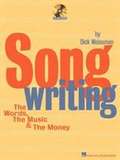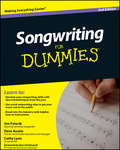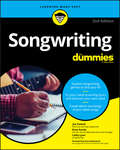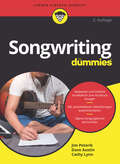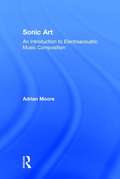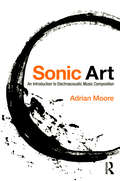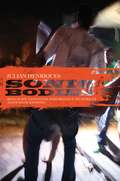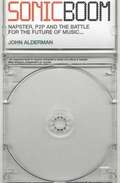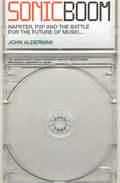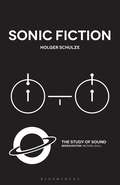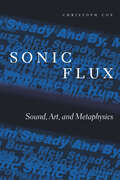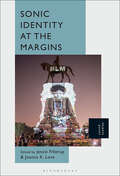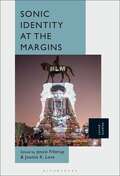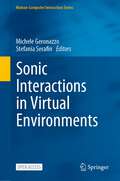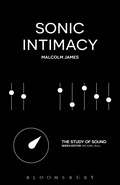- Table View
- List View
Songwriting: The Words, The Music and The Money (PDF) (Songwriting And Lyrics Ser.)
by Dick WeissmanAn excellent and essential primer for the aspiring tunesmith, Songwriting: The Words, the Music & Money offers authoritative tips on everything from basic song forms to the hard facts of succeeding in the music business. In between, veteran songwriter Dick Weissman shares his insights into composing effective lyrics, melodies and hooks, as well as detailed breakdowns of every musical style from folk to cabaret to hip hop. The first book on the topic to be accompanied by a CD covering all the musical concepts explored within, this is an invaluable resource for anyone engaged in the serious study of songwriting. No knowledge of musical notation is required. Dick Weissman is an Associate Professor of Music Business Management at the University of Colorado, and the former National Education Coordinator for the National Academy of Recording Arts and Sciences.
Songwriting For Dummies (For Dummies)
by Dave Austin Jim Peterik Cathy Lynn AustinProven techniques for songwriting success This friendly, hands-on guide tackles the new face of the recording industry, guiding you through the shift from traditional sales to downloads and mobile music, as well as how you can harness social media networks to get your music "out there." You get basic songwriting concepts, insider tips and advice, and inspiration for writing — and selling — meaningful, timeless songs. Songwriting 101 — get a grip on everything you need to know to write a song, from learning to listen to your "inner voice" to creating a "mood" and everything in between Jaunt around the genres — discover the variety of musical genres and find your fit, whether it's rock, pop, R&B, gospel, country, or more Let the lyrics out — master the art of writing lyrics, from finding your own voice to penning the actual words to using hooks, verses, choruses, and bridges Make beautiful music — find your rhythm, make melodies, and use chords to put the finishing touches on your song Work the Web — harness online marketing and social networks like Facebook, Twitter, and others to get your music heard by a whole new audience Open the book and find: What you need to know before you write a single note Tips on finding inspiration Ways to use poetic devices in lyrics Computer and Web-based shortcuts and technologies to streamline songwriting A look at famous songwriting collaborators Writing for stage, screen, and television How to make a demo to get your song heard Advice on how to make money from your music Learn to: Develop your songwriting skills with tips and techniques from the pros Use social networking sites to get your music out to the public Break into the industry with helpful, how-to instructions
Songwriting For Dummies
by Dave Austin Jim Peterik Cathy Lynn AustinProven techniques for songwriting success This friendly, hands-on guide tackles the new face of the recording industry, guiding you through the shift from traditional sales to downloads and mobile music, as well as how you can harness social media networks to get your music "out there." You get basic songwriting concepts, insider tips and advice, and inspiration for writing — and selling — meaningful, timeless songs. Songwriting 101 — get a grip on everything you need to know to write a song, from learning to listen to your "inner voice" to creating a "mood" and everything in between Jaunt around the genres — discover the variety of musical genres and find your fit, whether it's rock, pop, R&B, gospel, country, or more Let the lyrics out — master the art of writing lyrics, from finding your own voice to penning the actual words to using hooks, verses, choruses, and bridges Make beautiful music — find your rhythm, make melodies, and use chords to put the finishing touches on your song Work the Web — harness online marketing and social networks like Facebook, Twitter, and others to get your music heard by a whole new audience Open the book and find: What you need to know before you write a single note Tips on finding inspiration Ways to use poetic devices in lyrics Computer and Web-based shortcuts and technologies to streamline songwriting A look at famous songwriting collaborators Writing for stage, screen, and television How to make a demo to get your song heard Advice on how to make money from your music Learn to: Develop your songwriting skills with tips and techniques from the pros Use social networking sites to get your music out to the public Break into the industry with helpful, how-to instructions
Songwriting For Dummies
by Jim Peterik Dave Austin Cathy Lynn AustinProven techniques for songwriting success This friendly, hands-on guide tackles the new face of the recording industry, guiding you through the shift from traditional sales to downloads and mobile music, as well as how you can harness social media networks to get your music "out there." You get basic songwriting concepts, insider tips and advice, and inspiration for writing — and selling — meaningful, timeless songs. Songwriting 101 — get a grip on everything you need to know to write a song, from learning to listen to your "inner voice" to creating a "mood" and everything in between Jaunt around the genres — discover the variety of musical genres and find your fit, whether it's rock, pop, R&B, gospel, country, or more Let the lyrics out — master the art of writing lyrics, from finding your own voice to penning the actual words to using hooks, verses, choruses, and bridges Make beautiful music — find your rhythm, make melodies, and use chords to put the finishing touches on your song Work the Web — harness online marketing and social networks like Facebook, Twitter, and others to get your music heard by a whole new audience Open the book and find: What you need to know before you write a single note Tips on finding inspiration Ways to use poetic devices in lyrics Computer and Web-based shortcuts and technologies to streamline songwriting A look at famous songwriting collaborators Writing for stage, screen, and television How to make a demo to get your song heard Advice on how to make money from your music Songwriting For Dummies, 2nd Edition (9781119675655) was previously published as Songwriting For Dummies, 2nd Edition (9780470615140). While this version features a new Dummies cover and design, the content is the same as the prior release and should not be considered a new or updated product.
Songwriting For Dummies (For Dummies Ser.)
by Jim Peterik Dave Austin Cathy Lynn AustinProven techniques for songwriting success This friendly, hands-on guide tackles the new face of the recording industry, guiding you through the shift from traditional sales to downloads and mobile music, as well as how you can harness social media networks to get your music "out there." You get basic songwriting concepts, insider tips and advice, and inspiration for writing — and selling — meaningful, timeless songs. Songwriting 101 — get a grip on everything you need to know to write a song, from learning to listen to your "inner voice" to creating a "mood" and everything in between Jaunt around the genres — discover the variety of musical genres and find your fit, whether it's rock, pop, R&B, gospel, country, or more Let the lyrics out — master the art of writing lyrics, from finding your own voice to penning the actual words to using hooks, verses, choruses, and bridges Make beautiful music — find your rhythm, make melodies, and use chords to put the finishing touches on your song Work the Web — harness online marketing and social networks like Facebook, Twitter, and others to get your music heard by a whole new audience Open the book and find: What you need to know before you write a single note Tips on finding inspiration Ways to use poetic devices in lyrics Computer and Web-based shortcuts and technologies to streamline songwriting A look at famous songwriting collaborators Writing for stage, screen, and television How to make a demo to get your song heard Advice on how to make money from your music Songwriting For Dummies, 2nd Edition (9781119675655) was previously published as Songwriting For Dummies, 2nd Edition (9780470615140). While this version features a new Dummies cover and design, the content is the same as the prior release and should not be considered a new or updated product.
Songwriting für Dummies (Für Dummies)
by Jim Peterik Dave Austin Cathy LynnVon der Song-Idee zur Hitsingle: In diesem Buch finden Sie alles, was Sie wissen müssen, um mit Ihrem Song in der Musikindustrie Erfolg zu haben. Finden Sie den Stil, Rhythmus und Reim, der zu Ihrem Genre passt, und fesseln Sie Ihre Zuhörer mit eingängigen Texten und unvergesslichen Melodien. Mit vielen Übungen und Beispielen unterstützen die Autoren Sie bei den grundlegenden, kreativen Elementen des Songwriting, aber auch bei dem, was danach kommt: Demotape, Online-Marketing, digitale Downloads, Urheberrecht, Verträge, Agenten und Plattenfirmen - so lernen Sie, wie Sie mit Ihren Werken die größten Erfolge erzielen können.
Sonic Art: An Introduction To Electroacoustic Composition (PDF)
by Adrian MooreWritten by an active composer, performer and educator, Sonic Art: An Introduction to Electroacoustic Music Compositionprovides a clear and informative introduction to the compositional techniques behind electroacoustic music. It brings together theory, aesthetics, context and practical applications to allow students to start thinking about sound creatively, and gives them the tools to compose meaningful sonic art works. In addition to explaining the techniques and philosophies of sonic art, the book examines over forty composers and their works, introducing the history and context of notable pieces, and includes chapters on how to present compositions professionally, in performance and online. The book is supported by an online software toolkit which enables readers to start creating their own compositions. Encouraging a 'hands on' approach to working with sound, Sonic Artis the perfect introduction for anyone interested in electroacoustic music and crafting art from sounds.
Sonic Art: An Introduction to Electroacoustic Music Composition
by Adrian MooreWritten by an active composer, performer and educator, Sonic Art: An Introduction to Electroacoustic Music Composition provides a clear and informative introduction to the compositional techniques behind electroacoustic music. It brings together theory, aesthetics, context and practical applications to allow students to start thinking about sound creatively, and gives them the tools to compose meaningful sonic art works. In addition to explaining the techniques and philosophies of sonic art, the book examines over forty composers and their works, introducing the history and context of notable pieces, and includes chapters on how to present compositions professionally, in performance and online. The book is supported by an online software toolkit which enables readers to start creating their own compositions. Encouraging a ‘hands on’ approach to working with sound, Sonic Art is the perfect introduction for anyone interested in electroacoustic music and crafting art from sounds.
Sonic Art: An Introduction to Electroacoustic Music Composition
by Adrian MooreWritten by an active composer, performer and educator, Sonic Art: An Introduction to Electroacoustic Music Composition provides a clear and informative introduction to the compositional techniques behind electroacoustic music. It brings together theory, aesthetics, context and practical applications to allow students to start thinking about sound creatively, and gives them the tools to compose meaningful sonic art works. In addition to explaining the techniques and philosophies of sonic art, the book examines over forty composers and their works, introducing the history and context of notable pieces, and includes chapters on how to present compositions professionally, in performance and online. The book is supported by an online software toolkit which enables readers to start creating their own compositions. Encouraging a ‘hands on’ approach to working with sound, Sonic Art is the perfect introduction for anyone interested in electroacoustic music and crafting art from sounds.
Sonic Bodies: Reggae Sound Systems, Performance Techniques, and Ways of Knowing
by Julian HenriquesThe reggae sound system has exerted a major influence on music and popular culture. Out on the streets of inner city Kingston, Jamaica, every night, sound systems stage dancehall sessions for the crowd to share the immediate, intensive and immersive visceral pleasures of sonic dominance. Sonic Bodies concentrates on the skilled performance of the crewmembers responsible for this signature sound of Jamaican music: the audio engineers designing, building and fine-tuning the hugely powerful "sets" of equipment; the selectors choosing the music tracks to play; and MCs(DJs) on the mic hyping up the crowd.Julian Henriques proposes that these dancehall "vibes" are taken literally as the periodic motion of vibrations. He offers an analysis of how a sound system operates - at auditory, corporeal and sociocultural frequencies. Sonic Bodies formulates a fascinating critique of visual dominance and the dualities inherent in ideas of image, text or discourse. This innovative book questions the assumptions that reason resides only in a disembodied mind, that communication is an exchange of information, and that meaning is only ever representation.
Sonic Bodies: Reggae Sound Systems, Performance Techniques, and Ways of Knowing
by Julian HenriquesThe reggae sound system has exerted a major influence on music and popular culture. Out on the streets of inner city Kingston, Jamaica, every night, sound systems stage dancehall sessions for the crowd to share the immediate, intensive and immersive visceral pleasures of sonic dominance. Sonic Bodies concentrates on the skilled performance of the crewmembers responsible for this signature sound of Jamaican music: the audio engineers designing, building and fine-tuning the hugely powerful "sets" of equipment; the selectors choosing the music tracks to play; and MCs(DJs) on the mic hyping up the crowd.Julian Henriques proposes that these dancehall "vibes" are taken literally as the periodic motion of vibrations. He offers an analysis of how a sound system operates - at auditory, corporeal and sociocultural frequencies. Sonic Bodies formulates a fascinating critique of visual dominance and the dualities inherent in ideas of image, text or discourse. This innovative book questions the assumptions that reason resides only in a disembodied mind, that communication is an exchange of information, and that meaning is only ever representation.
Sonic Boom: Napster, P2P and the Battle for the Future of Music (PDF)
by John AldermanThe first book to tell the inside story of the battle for control over the future of music and how technology is ripping up the traditional rules of business. As the internet grew throughout the 1990s, software was developed, such as Liquid Audio and MP3, that could deliver music anywhere and most importantly for free. Bands were reaching fans without record company support; entrepreneurs made money distributing digital music files without licensing agreements; the music industry executives complained of piracy and refused to embrace the Information Age.
Sonic Boom: Napster, P2p And The Battle For The Future Of Music
by John AldermanThe first book to tell the inside story of the battle for control over the future of music and how technology is ripping up the traditional rules of business.
Sonic Fiction (The Study of Sound)
by Holger SchulzeSonic fiction is everywhere: in conversations about vernacular culture, in music videos, sound art compositions and on record sleeves, in everyday encounters with sonic experiences and in every single piece of writing about sound. Where one can find sounds one will also detect bits of fiction.In 1998 music critic, DJ and video essayist Kodwo Eshun proposed this concept in his book “More Brilliant Than The Sun: Adventures in Sonic Fiction”. Originally, he did so in order to explicate the manifold connections between Afrofuturism and Techno, connecting them to Jazz, Breakbeat and Electronica. His argument, his narrations and his explorative language operations however inspired researchers, artists, and scholars since then. Sonic Fiction became a myth and a mantra, a keyword and a magical spell. This book provides a basic introduction to sonic fiction. In six chapters it explicates the inspirations for and the transformations of this concept; it explores applications and extrapolations in sound art and sonic theory, in musicology, epistemology, in critical and political theory. Sonic fiction is presented in this book as a heuristic for critique and activism.
Sonic Fiction (The Study of Sound)
by Holger SchulzeSonic fiction is everywhere: in conversations about vernacular culture, in music videos, sound art compositions and on record sleeves, in everyday encounters with sonic experiences and in every single piece of writing about sound. Where one can find sounds one will also detect bits of fiction.In 1998 music critic, DJ and video essayist Kodwo Eshun proposed this concept in his book “More Brilliant Than The Sun: Adventures in Sonic Fiction”. Originally, he did so in order to explicate the manifold connections between Afrofuturism and Techno, connecting them to Jazz, Breakbeat and Electronica. His argument, his narrations and his explorative language operations however inspired researchers, artists, and scholars since then. Sonic Fiction became a myth and a mantra, a keyword and a magical spell. This book provides a basic introduction to sonic fiction. In six chapters it explicates the inspirations for and the transformations of this concept; it explores applications and extrapolations in sound art and sonic theory, in musicology, epistemology, in critical and political theory. Sonic fiction is presented in this book as a heuristic for critique and activism.
Sonic Flux: Sound, Art, and Metaphysics
by Christoph CoxFrom Edison’s invention of the phonograph through contemporary field recording and sound installation, artists have become attracted to those domains against which music has always defined itself: noise, silence, and environmental sound. Christoph Cox argues that these developments in the sonic arts are not only aesthetically but also philosophically significant, revealing sound to be a continuous material flow to which human expressions contribute but which precedes and exceeds those expressions. Cox shows how, over the course of the twentieth and twenty-first centuries, philosophers and sonic artists have explored this “sonic flux.” Through the philosophical analysis of works by John Cage, Maryanne Amacher, Max Neuhaus, Christian Marclay, and many others, Sonic Flux contributes to the development of a materialist metaphysics and poses a challenge to the prevailing positions in cultural theory, proposing a realist and materialist aesthetics able to account not only for sonic art but for artistic production in general.
Sonic Flux: Sound, Art, and Metaphysics
by Christoph CoxFrom Edison’s invention of the phonograph through contemporary field recording and sound installation, artists have become attracted to those domains against which music has always defined itself: noise, silence, and environmental sound. Christoph Cox argues that these developments in the sonic arts are not only aesthetically but also philosophically significant, revealing sound to be a continuous material flow to which human expressions contribute but which precedes and exceeds those expressions. Cox shows how, over the course of the twentieth and twenty-first centuries, philosophers and sonic artists have explored this “sonic flux.” Through the philosophical analysis of works by John Cage, Maryanne Amacher, Max Neuhaus, Christian Marclay, and many others, Sonic Flux contributes to the development of a materialist metaphysics and poses a challenge to the prevailing positions in cultural theory, proposing a realist and materialist aesthetics able to account not only for sonic art but for artistic production in general.
Sonic Flux: Sound, Art, and Metaphysics
by Christoph CoxFrom Edison’s invention of the phonograph through contemporary field recording and sound installation, artists have become attracted to those domains against which music has always defined itself: noise, silence, and environmental sound. Christoph Cox argues that these developments in the sonic arts are not only aesthetically but also philosophically significant, revealing sound to be a continuous material flow to which human expressions contribute but which precedes and exceeds those expressions. Cox shows how, over the course of the twentieth and twenty-first centuries, philosophers and sonic artists have explored this “sonic flux.” Through the philosophical analysis of works by John Cage, Maryanne Amacher, Max Neuhaus, Christian Marclay, and many others, Sonic Flux contributes to the development of a materialist metaphysics and poses a challenge to the prevailing positions in cultural theory, proposing a realist and materialist aesthetics able to account not only for sonic art but for artistic production in general.
Sonic Flux: Sound, Art, and Metaphysics
by Christoph CoxFrom Edison’s invention of the phonograph through contemporary field recording and sound installation, artists have become attracted to those domains against which music has always defined itself: noise, silence, and environmental sound. Christoph Cox argues that these developments in the sonic arts are not only aesthetically but also philosophically significant, revealing sound to be a continuous material flow to which human expressions contribute but which precedes and exceeds those expressions. Cox shows how, over the course of the twentieth and twenty-first centuries, philosophers and sonic artists have explored this “sonic flux.” Through the philosophical analysis of works by John Cage, Maryanne Amacher, Max Neuhaus, Christian Marclay, and many others, Sonic Flux contributes to the development of a materialist metaphysics and poses a challenge to the prevailing positions in cultural theory, proposing a realist and materialist aesthetics able to account not only for sonic art but for artistic production in general.
Sonic Flux: Sound, Art, and Metaphysics
by Christoph CoxFrom Edison’s invention of the phonograph through contemporary field recording and sound installation, artists have become attracted to those domains against which music has always defined itself: noise, silence, and environmental sound. Christoph Cox argues that these developments in the sonic arts are not only aesthetically but also philosophically significant, revealing sound to be a continuous material flow to which human expressions contribute but which precedes and exceeds those expressions. Cox shows how, over the course of the twentieth and twenty-first centuries, philosophers and sonic artists have explored this “sonic flux.” Through the philosophical analysis of works by John Cage, Maryanne Amacher, Max Neuhaus, Christian Marclay, and many others, Sonic Flux contributes to the development of a materialist metaphysics and poses a challenge to the prevailing positions in cultural theory, proposing a realist and materialist aesthetics able to account not only for sonic art but for artistic production in general.
Sonic Flux: Sound, Art, and Metaphysics
by Christoph CoxFrom Edison’s invention of the phonograph through contemporary field recording and sound installation, artists have become attracted to those domains against which music has always defined itself: noise, silence, and environmental sound. Christoph Cox argues that these developments in the sonic arts are not only aesthetically but also philosophically significant, revealing sound to be a continuous material flow to which human expressions contribute but which precedes and exceeds those expressions. Cox shows how, over the course of the twentieth and twenty-first centuries, philosophers and sonic artists have explored this “sonic flux.” Through the philosophical analysis of works by John Cage, Maryanne Amacher, Max Neuhaus, Christian Marclay, and many others, Sonic Flux contributes to the development of a materialist metaphysics and poses a challenge to the prevailing positions in cultural theory, proposing a realist and materialist aesthetics able to account not only for sonic art but for artistic production in general.
Sonic Identity at the Margins
by Jessie Fillerup and Joanna K. LoveSonic Identity at the Margins convenes the interdisciplinary work of 17 academics, composers, and performers to examine sonic identity from the 19th century to the present. Recognizing the myriad aspects of identity formation, the authors in this volume adopt methodological approaches that range from personal accounts and embodied expression to archival research and hermeneutic interpretation. They examine real and imagined spaces-from video games and monument sites to films and depictions of outer space-by focusing on sonic creation, performance, and reception. Drawing broadly from artistic and performance disciplines, the authors reimagine the roles played by music and sound in constructing notions of identity in a broad array of musical experiences, from anti-slavery songsters to Indigenous tunes and soundscapes, noise and multimedia to popular music and symphonic works. Exploring relationships between sound and various markers of identity-including race, gender, ability, and nationality-the authors explore challenging, timely topics, including the legacies of slavery, indigeneity, immigration, and colonial expansion. In heeding recent calls to decolonize music studies and confront its hegemonic methods, the authors interrogate privileged perspectives embedded in creating, performing, and listening to sound, as well as the approaches used to analyze these experiences.
Sonic Identity at the Margins
Sonic Identity at the Margins convenes the interdisciplinary work of 17 academics, composers, and performers to examine sonic identity from the 19th century to the present. Recognizing the myriad aspects of identity formation, the authors in this volume adopt methodological approaches that range from personal accounts and embodied expression to archival research and hermeneutic interpretation. They examine real and imagined spaces-from video games and monument sites to films and depictions of outer space-by focusing on sonic creation, performance, and reception. Drawing broadly from artistic and performance disciplines, the authors reimagine the roles played by music and sound in constructing notions of identity in a broad array of musical experiences, from anti-slavery songsters to Indigenous tunes and soundscapes, noise and multimedia to popular music and symphonic works. Exploring relationships between sound and various markers of identity-including race, gender, ability, and nationality-the authors explore challenging, timely topics, including the legacies of slavery, indigeneity, immigration, and colonial expansion. In heeding recent calls to decolonize music studies and confront its hegemonic methods, the authors interrogate privileged perspectives embedded in creating, performing, and listening to sound, as well as the approaches used to analyze these experiences.
Sonic Interactions in Virtual Environments (Human–Computer Interaction Series)
by Michele Geronazzo Stefania SerafinThis open access book tackles the design of 3D spatial interactions in an audio-centered and audio-first perspective, providing the fundamental notions related to the creation and evaluation of immersive sonic experiences. The key elements that enhance the sensation of place in a virtual environment (VE) are:Immersive audio: the computational aspects of the acoustical-space properties of Virutal Reality (VR) technologies Sonic interaction: the human-computer interplay through auditory feedback in VEVR systems: naturally support multimodal integration, impacting different application domainsSonic Interactions in Virtual Environments will feature state-of-the-art research on real-time auralization, sonic interaction design in VR, quality of the experience in multimodal scenarios, and applications. Contributors and editors include interdisciplinary experts from the fields of computer science, engineering, acoustics, psychology, design, humanities, and beyond. Their mission is to shape an emerging new field of study at the intersection of sonic interaction design and immersive media, embracing an archipelago of existing research spread in different audio communities and to increase among the VR communities, researchers, and practitioners, the awareness of the importance of sonic elements when designing immersive environments.
Sonic Intimacy: Reggae Sound Systems, Jungle Pirate Radio and Grime YouTube Music Videos (The Study of Sound)
by Malcolm James'Sonic intimacy' is a key concept through which sound, human and technological relations can be assessed in relation to racial capitalism. What is sonic intimacy, how is it changing and what is at stake in its transformation, are questions that should concern us all. Through an analysis of alternative music cultures of the Black Atlantic (reggae sound systems, jungle pirate radio and grime YouTube music videos), Malcolm James critically shows how sonic intimacy pertains to modernity's social, psychic, spatial and temporal movements. This book explores what is urgently at stake in the development of sonic intimacy for human relations and alternative black and anti-capitalist public politics.
